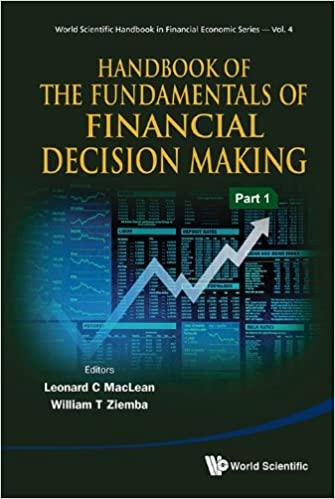Answered step by step
Verified Expert Solution
Question
1 Approved Answer
How can I solve this Based on the primer (Exhibit 1), the ides was to use calk on the S6P 500 Index. The payoff at
How can I solve this 

Based on the primer (Exhibit 1), the ides was to use calk on the S6P 500 Index. The payoff at maturity was based on the return on the SaxP 500 Index. For example, if the current level of the \$xkP 500 Index was 1.00 (say 1,900 index points), the calls would have to be wnitten with a strike price also equal to 1.00 (1,900)/1,900)=1.000. The maturity date would be one year from the date of investment. The payoff was based on the value of the index at maturity, and the notional value was $1 mition. If, at maturity, the SacP 500 Index was 2090 , the call value woald be based on an index value of 1.10=2,090/1,900, and the call would have a value of (1.101.001)$1 million =$0.10 million, Casals had looked op some of the pricing inputs, Volarility of the SRPP 500 Indes was around 25%. He would assume that the SeP So0 Index had no dividend yield. The risk-free interest rate (with continuous compounding was currently 6%. He wanted to work out the answers to a few specific questions: 1. How should the bank allocate the $1 million to deliver this IPP-HiN to the client? 2. Was this PP-EIINa "fait" deal ro the client of would the bank eara a fece on this product? 3. Casals's first clicnt Eked the $1 million capital guarantecd but wanted 50% (not 406 ) of the increase in the Soep 500 Index. He planned to ask whether the client wotild accept a cap on her gatts if the SacP 500 rose by more than 20R h. This meant that the dient's return was lemited to 10 fis cven if the index appecciated more than 20%. See Table 1 for detalle. How could the bank add this extra feature to the PP.FHL? Exhibit 1 (continued) Payout analysis for the hypothetical PP-EL N. Based on the primer (Exhibit 1), the ides was to use calk on the S6P 500 Index. The payoff at maturity was based on the return on the SaxP 500 Index. For example, if the current level of the \$xkP 500 Index was 1.00 (say 1,900 index points), the calls would have to be wnitten with a strike price also equal to 1.00 (1,900)/1,900)=1.000. The maturity date would be one year from the date of investment. The payoff was based on the value of the index at maturity, and the notional value was $1 mition. If, at maturity, the SacP 500 Index was 2090 , the call value woald be based on an index value of 1.10=2,090/1,900, and the call would have a value of (1.101.001)$1 million =$0.10 million, Casals had looked op some of the pricing inputs, Volarility of the SRPP 500 Indes was around 25%. He would assume that the SeP So0 Index had no dividend yield. The risk-free interest rate (with continuous compounding was currently 6%. He wanted to work out the answers to a few specific questions: 1. How should the bank allocate the $1 million to deliver this IPP-HiN to the client? 2. Was this PP-EIINa "fait" deal ro the client of would the bank eara a fece on this product? 3. Casals's first clicnt Eked the $1 million capital guarantecd but wanted 50% (not 406 ) of the increase in the Soep 500 Index. He planned to ask whether the client wotild accept a cap on her gatts if the SacP 500 rose by more than 20R h. This meant that the dient's return was lemited to 10 fis cven if the index appecciated more than 20%. See Table 1 for detalle. How could the bank add this extra feature to the PP.FHL? Exhibit 1 (continued) Payout analysis for the hypothetical PP-EL N 

Step by Step Solution
There are 3 Steps involved in it
Step: 1

Get Instant Access to Expert-Tailored Solutions
See step-by-step solutions with expert insights and AI powered tools for academic success
Step: 2

Step: 3

Ace Your Homework with AI
Get the answers you need in no time with our AI-driven, step-by-step assistance
Get Started


